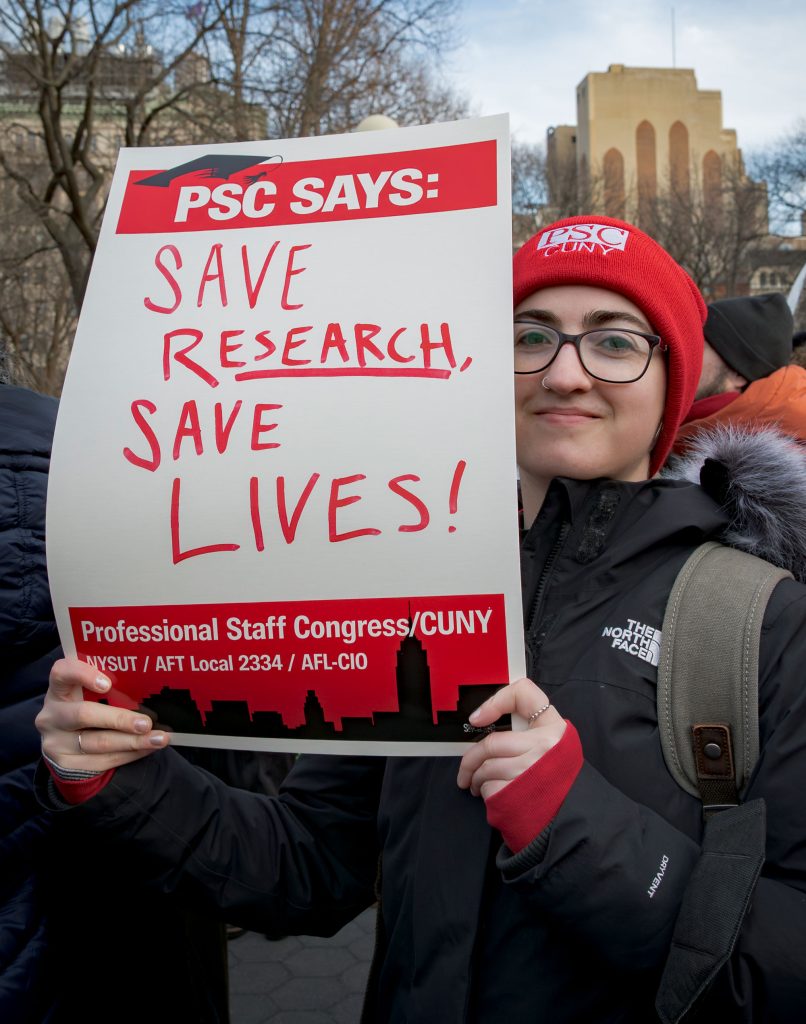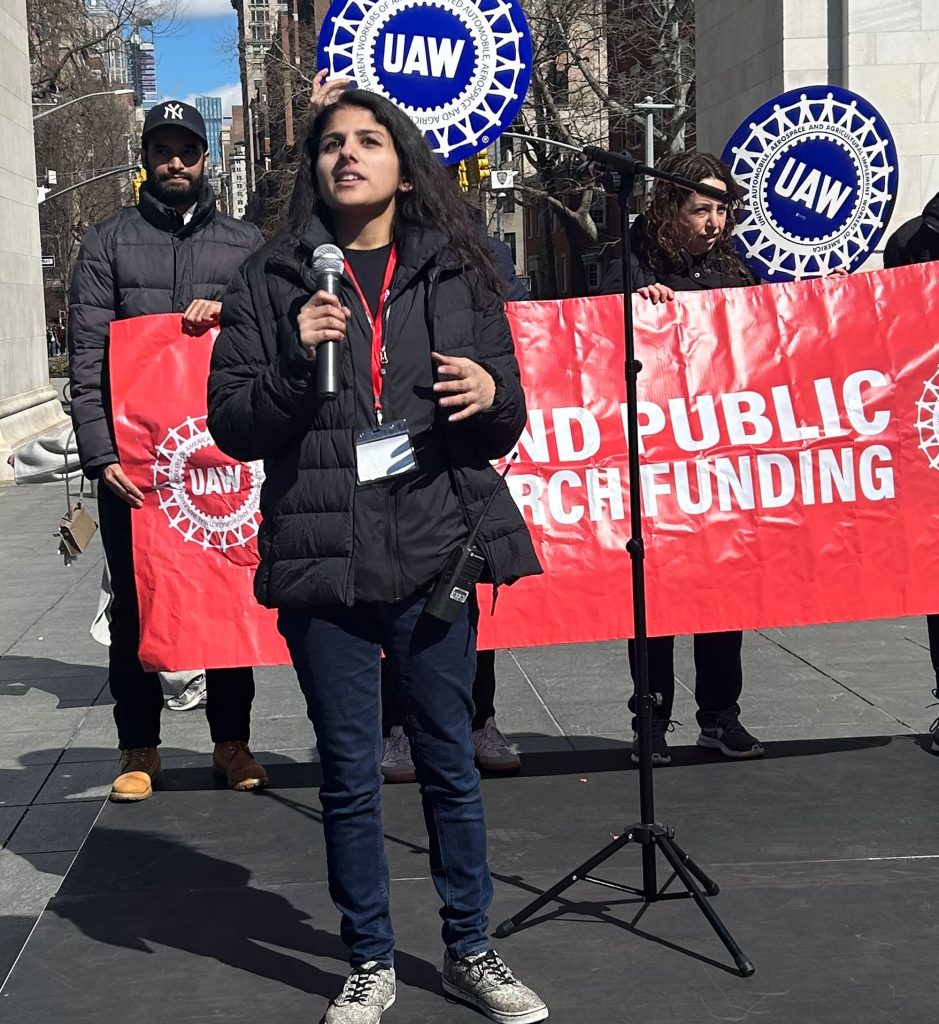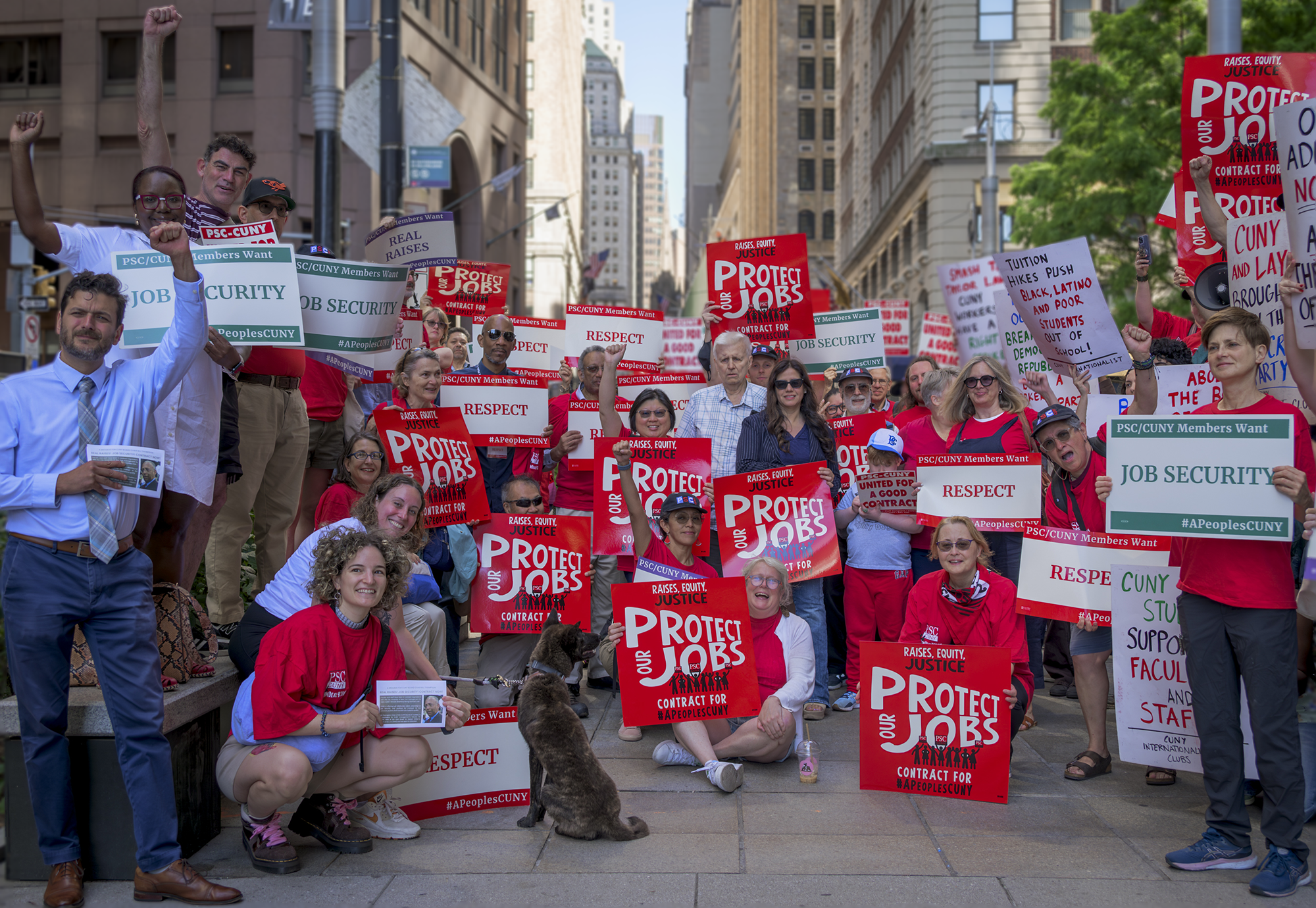Lucas Parra, a professor of biomedical engineering at City College, looked out over the more than 1,000 demonstrators in Washington Square Park on March 7, demanding a reversal of the Trump administration cuts and proposed cuts to federal agencies and National Institutes of Health funding to universities. The drivers of innovation in the United States, Parra told the crowd, were not in pharmaceutical company laboratories or in other for-profit corporations.
“The magic happens at teaching hospitals and research institutions,” he said to the crowd’s applause, adding that these institutions allow scientists and researchers “the space and time to do more things.”
Layoffs
Parra was one of many CUNY science faculty and PSC members who came to the demonstration, rallying with scientists, academics and supporters from universities, hospitals and other institutions around the city. The Trump administration, through its newly created Department of Government Efficiency, has laid off staff at vital scientific and environmental agencies.
The resistance to the destruction has been constant and has had

PSC members support federal science funding. (Credit: Erik McGregor)
some success. A day before the rally a federal judge had “blocked the Trump administration from drastically cutting medical research funding that many scientists say will endanger patients and cost jobs,” the Associated Press reported, noting that “a new National Institutes of Health policy would strip research groups of hundreds of millions of dollars to cover so-called indirect expenses of studying Alzheimer’s, cancer, heart disease and a host of other illnesses – anything from clinical trials of new treatments to basic lab research that is the foundation for discoveries.”
But despite this judicial reprieve, the attack on scientific research has been unending, as the administration has promised deep cuts. “Almost immediately after being sworn in as president…Trump put his signature to piles of executive orders canceling or freezing tens of billions of dollars in funding for research and international assistance, and putting the seal on thousands of layoffs,” reported Nature. “Orwellian restrictions have been placed on research, including bans on studies that mention particular words relating to sex and gender, race, disability and other protected characteristics.”
CUNY IMPACTED
This is the environment PSC members are fighting against. “They’re not just coming for efficiency,” PSC President James Davis told the crowd in Washington Square Park. “They’re coming after tens of millions of dollars that go to the City University of New York, that help to fund the science research that our graduate students are leading, that our undergraduate students are studying.”
For Srishti Bose, a PhD student at the Graduate Center studying neuroscience, all scientific disciplines are connected to one another. Funding for her work could help psychological and sociological research into drug addiction, which could alleviate inequality and general social suffering, she said. “The attacks on research affect everyone: This is public health. This spreads out to other areas of science. All science is for the public good.”
PUBLIC SERVICE
Kyle McDonald, a professor of earth and atmospheric sciences at City College, said that a student in his program worked years to attain a PhD, eventually became a consultant at the National Oceanic and Atmospheric Administration, and was only recently brought on as a full employee. Then the new Trump administration fired her for no reason other than its desire to cut federal spending, McDonald said.

Srishti Bose, who studies neuroscience at the Graduate Center. (Credit: Ari Paul)
“That is just one story,” he said. “These people are there because they believe in the work. It’s public service.”
He also worried that these cuts would result in a “brain drain” in American society, noting that a colleague in Montreal told him that his Canadian institution is seeing a sudden increase in the number of job applications from American scientists. He also worried that a lack of scientific funding would impede new medical advances, a fear he took personally. “I’m a cancer survivor because of science,” McDonald said.
Denis Nash, a distinguished professor at the Graduate School of Public Health & Health Policy and the executive director of the CUNY Institute for Implementation Science in Population Health, said, “The cuts and funding stagnation at NIH are already having a chilling effect on research at CUNY. As a public university, we rely heavily on federal grants to support our research, train students and generate new scientific knowledge. With existing grants from NIH, CDC and USAID threatened, critical research gets disrupted, studies that thousands of volunteers have signed up for will be paused or worse, and CUNY researchers will have more difficulty winning and sustaining long-term projects. This disproportionately affects early-career scholars, who have fewer alternative funding sources, and those studying health disparities – an area where CUNY researchers and scholars have historically made significant contributions. If these cuts continue, it will mean fewer opportunities for students to engage in cutting-edge research projects, studies and datasets, and it will also mean fewer scientific breakthroughs and a diminished ability to address pressing public health challenges.”
Nash noted that funding cuts to CUNY scholars negatively impact the community in general, saying, “When research funding declines, we lose the ability to study and respond to public health crises, from infectious diseases to environmental health threats. NIH- and CDC-supported studies at CUNY have directly informed policy and healthcare interventions, particularly for marginalized communities. Cuts to research funding mean fewer studies on health disparities, less innovation in health-care delivery and lost opportunities to train the next generation of public health scientists and healthcare leaders. Ultimately, these cuts don’t just hurt CUNY – they hurt the public who rely on evidence-based solutions to pressing health challenges.”
Nash lamented that while his institution has been supportive of faculty at this critical time, CUNY’s top leadership has not been a part of the pushback.
“Unfortunately, this silence is not unique to CUNY – it reflects a broader pattern across U.S. universities, including university leadership, administrators and even faculty. Some may believe staying quiet will allow them to ‘fly under the radar,’ but that is a miscalculation. Academia is under siege, and if we do not band together to speak out and defend the role of science and scholarship, we risk irreparable damage,” he said. “CUNY leadership, including Central administration, college presidents and faculty, would ideally step into thought leadership roles, raise awareness and create space for meaningful discussions across NYC. To lead the way. If CUNY doesn’t take a stand, who will? This moment requires all hands on deck.”
Other speakers addressed the fact that these grants do incredible good for the public in New York beyond just scientific work. For example, Josh Dubnau, a professor of neurobiology and behavior at Stony Brook University, said, “My own lab is funded by grants from the NIH to support our research into causes of ALS and Alzheimer’s. These grants support the salaries and training of five PhD candidates, three postdoctoral scientists, one technician and two undergraduates. The additional so-called ‘indirect costs’ that the NIH and other federal agencies provide to support the overhead of research supports the jobs of plumbers, electricians, carpenters, HVAC experts, admin assistants, janitors and others. Funding from just the NIH to New York creates 20,000 jobs.”
Kelly Karst, a library faculty member at Brooklyn College, attended the rally because she believed that any cuts in funding would hurt BC’s student body. “Our students rely on research,” she said. “What will our students do? How will they continue the scholarly conversation?”
DEFENDING KNOWLEDGE
While scientists from private institutions spoke eloquently about the need for federal investment in scientific and medical research, Karst believed the cuts would be devastating to a place like CUNY, which is meant to serve New York City’s working class. “It’s just further gatekeeping,” she said, noting that the system has been systematically underfunded over the decades. “We can’t take one more cut.”
Bose, speaking to the crowd, noted that the scientists rallying in Washington Square Park weren’t just defending funding for their jobs or their institutions, but were rallying for investments in public health and for advancements that could help society as a whole.
“You’re showing up for the United States of America,” she said.

